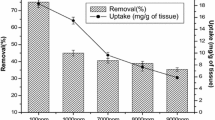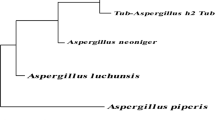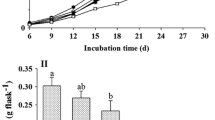Abstract
The ability of the heavy metal-tolerant fungus Paecilomyces marquandii to modulate whole cells fatty acid composition and saturation in response to IC50 of Cd, Pb, Zn, Ni, and Cu was studied. Cadmium and nickel caused the most significant growth reduction. In the mycelia cultured with all tested metals, with the exception of nickel, a rise in the fatty acid unsaturation was noted. The fungus exposure to Pb, Cu, and Ni led to significantly higher lipid peroxidation. P. marquandii incubated in the presence of the tested metals responded with an increase in the level of linoleic acid and escalation of electrolyte leakage. The highest efflux of electrolytes was caused by lead. In these conditions, the fungus was able to bind up to 100 mg g−1 of lead, whereas the content of the other metals in the mycelium was significantly lower and reached from 3.18 mg g−1 (Cu) to 15.21 mg g−1 (Zn). Additionally, it was shown that ascorbic acid at the concentration of 1 mM protected fungal growth and prevented the changes in the fatty acid composition and saturation but did not alleviate lipid peroxidation or affect the increased permeability of membranes after lead exposure. Pro-oxidant properties of ascorbic acid in the copper-stressed cells manifested strong growth inhibition and enhanced metal accumulation as a result of membrane damage. Toxic metals action caused cellular modulations, which might contributed to P. marquandii tolerance to the studied metals. Moreover, these changes can enhance metal removal from contaminated environment.





Similar content being viewed by others
References
Alcain JF, Buron IM (1994) Ascorbate on cell growth and differentiation. J Bioenerg Biomembr 4:393–398
Azevedo MM, Carvalho A, Pascoal C, Rodrigues F, Fernanda C (2007) Responses of antioxidant defenses to Cu and Zn stress in two aquatic fungi. Sci Total Environ 377:233–243
Bernat P, Długoński J (2007) Tributyltin chloride interactions with fatty acids composition and degradation ability of the filamentous fungus Cunninghamella elegans. Int Biodeterior Biodegrad 60:133–136
Bernat P, Słaba M, Długoński J (2009) Action of tributyltin on lipid content and potassium retention In the organotins degrading fungus Cunninghamella elegans. Curr Microbiol 59:315–320
Bhainsa KC, D’Souza SF (2008) Removal of copper ions by the filamentous fungus, Rhizopus oryzae from aqueous solution. Bioresour Technol 99:3829–3835
Bremner I (1998) Manifestations of copper excess. Am J Clin Nutr 67:1069S–1073S
Casalino E, Calzaretti G, Sblano C, Landriscina C (2000) Cadmium-dependent enzyme activity alteration is not imputable to lipid peroxidation. Arch Biochem Biophys 383:288–295
Catalá A (2009) Lipid peroxidation of membrane phospholipids generates hydroxyl-alkenals and oxidized phospholipids active in physiological and/or pathological conditions. Chem Phys Lipid 157:1–11
Čertík M, Breierová E, Juršíková P (2005) Effect of cadmium on lipid composition of Aureobasidium pullulans grown with added extracellular polysaccharides. Int Biodeterior Biodegrad 55:195–202
Chakraborty P, Babu PVR, Sarma VV (2012) A study of lead and cadmium speciation in some estuarine and coastal sediments. Chem Geol 294–295:217–225
Chaoui A, Mazhoudi S, Ghorbal MH, Ferjani EE (1997) Cadmium and zinc induction of lipid peroxidation and effects on antioxidant enzyme activities in bean (Phaseolus vulgaris L.). Plant Sci 127:139–147
Ding J, Huang X, Zhang L, Zhao N, Yang D, Zhang K (2009) Tolerance and stress response to ethanol in the yeast Saccharomyces cerevisiae. Appl Microbiol Biotechnol 85:253–256
Duarte TL, Jones GD (2007) Vitamin C modulation of H2O2-induced damage and iron homeostasis in human cells. Free Radic Biol Med 43:1165–1175
Dufoure EJ (2008) Sterols and membrane dynamics. J Chem Biol 1:63–67
Gadd GM (2010) Metals, minerals and microbes: geomicrobiology and bioremediation. Microbiology 156:609–643
Gajewska E, Skłodowska M (2010) Differential effect of equal copper, cadmium and nickel concentration on biochemical reactions in wheat seedlings. Ecotoxicol Environ Saf 73:996–1003
Gajewska E, Słaba M, Andrzejewska R, Skłodowska M (2006) Nickel-induced inhibition of wheat root growth is related to H2O2 production, but not to lipid peroxidation. Plant Growth Regul 49:95–103
Georgiou Ch D, Zervoudakis G, Petropoulou KP (2003) Ascorbic acid may play a role in the sclerotial differentiation of Sclerotium rolfsii. Mycologia 95:308–316
Halter D, Casiot C, Heipieper HJ, Plewniak F, Marchal M, Simon S, Arsene-Ploetze F, Bertin PN (2012) Surface properties and intracellular speciation revealed an original adaptive mechanism to arsenic in the acid mine drainage bio-indicator Euglena mutabilis. Appl Microbiol Biotechnol 93:1735–1744
Heipieper HJ, Weber FJ, Sikkema J, Keweloh H, de Bont JAM (1994) Mechanisms behind resistance of whole cells to toxic organic solvents. Trends Biotechnol 12:409–415
Heipieper HJ, Isken S, Saliola M (2000) Ethanol tolerance and membrane fatty acid adaptation in adh multiple and null mutants of Kluyveromyces lactis. Res Microbiol 151:777–784
Howlett NG, Avery SV (1997) Induction of lipid peroxidation during heavy metal stress in Saccharomyces cerevisiae and influence of plasma membrane fatty acid unsaturation. Appl Environ Microbiol 62:3960–3966
Ikonen E (2001) Roles of lipid rafts in membrane transport. Curr Opin Cell Biol 13:470–477
Jomova K, Valko M (2011) Advances in metal-induced oxidative stress and human disease. Toxicology 283:65–87
Karamać M (2007) Fe (II) Cu (II) chelating activity of buckwheat and buckwheat groats tannin fractions. Pol J Food Nutr Sci 57:357–362
Masood A, Shah NA, Zeeshan M, Abraham G (2006) Differential response of antioxidant enzymes to salinity stress in two varieties of Azolla (Azolla pinnata and Azolla filiculoides). Environ Exp Bot 58:216–222
Mukherjee A, Das D, Mondal SK, Biswas R, Das TK, Boujedaini N, Khuda-Bukhsh AR (2010) Tolerance of arsenate-induced stress in Aspergillus niger, a possible candidate for bioremediation. Ecotoxicol Environ Saf 73:172–182
Nies DH (1999) Microbial heavy-metal resistance. Appl Microbiol Biotechnol 51:730–750
Pande M, Flora SJS (2002) Lead induced oxidative damage and its response to combined administration of α-lipoic acid and succimers in rats. Toxicology 177:187–196
Paraszkiewicz K, Frycie A, Słaba M, Długoński J (2007) Enhancement of emulsifier production by Curvularia lunata in cadmium, zinc and lead presence. BioMetals 20:797–805
Paraszkiewicz K, Bernat P, Długoński J (2009) Effect of nickel, copper, and zinc on emulsifier production and saturation of cellular fatty acids in filamentous fungus Curvularia lunata. Int Biodeterior Biodegrad 63:100–105
Paraszkiewicz K, Bernat P, Naliwajski M, Długoński J (2010) Lipid peroxidation in the fungus Curvularia lunata exposed to nickel. Arch Microbiol 192:135–141
Porter NA, Caldwell SE, Mills KA (1995) Mechanisms of free radical oxidation of unsaturated lipids. Lipid 30:277–290
Re R, Pellegrini N, Proteggente A, Pannala A, Yang M, Rice-Evans C (1999) Antioxidant activity applying an improved ABTS radical cation decolorization assay. Free Radic Biol Med 26:1231–1237
Rodríguez-Vargas S, Sánchez-García A, Martínez-Rivas JM, Prieto JA, Randez-Gil F (2007) Fluidization of membrane lipids enhances the tolerance of Saccharomyces cerevisiae to freezing and salt stress. Appl Environ Microbiol 73:110–116
Różalska S, Szewczyk R, Długoński J (2010) Biodegradation of 4-n-nonylphenol by the non-ligninolytic filamentous fungus Gliocephalotrichum simplex: A proposal of a metabolic pathway. J Hazard Mater 180:323–331
Sandhir R, Gill KD (1995) Effect of lead on lipid peroxidation in liver of rats. Biol Trace Elem Res 48:91–97
Sayer JA, Gadd GM (1997) Solubilization and transformation of insoluble inorganic metal compounds to insoluble metal oxalates by Aspergillus niger. Mycol Res 101:653–661
Shahid M, Pinell E, Dumat C (2012) Review of Pb availability and toxicity to plant in relation with metal speciation; role of synthetic and natural organic ligands. J Hazard Mater 219–220:1–12
Shu X, Yin LY, Zhang QF, Wang WB (2012) Effect of Pb toxicity on leaf growth, antioxidant enzyme activities, and photosynthesis in cuttings and seedlings of Jatropha curcas L. Environ Sci Pollut Res 19:893–902
Silver S, Phung LT (2009) Heavy metals, bacterial resistance. In: Schaechter M, Schaechter M (eds) Encyclopedia of Microbiology. Elsevier, Oxford, pp 220–227
Słaba M, Długoński J (2000) Selective recovery of Zn2+ from waste slag from a metal-processing plant by microscopic fungus Verticillium marquandii. Biotechnol Lett 22:1699–1704
Słaba M, Długoński J (2011) Efficient Zn2+ and Pb2+ uptake by filamentous fungus Paecilomyces marquandii with engagement of metal hydrocarbonates precipitation. Int Biodeterior Biodegrad 65:954–960
Słaba M, Bizukojć M, Pałecz B, Długoński J (2005) Kinetic study of toxicity of zinc and lead ions to the heavy metals accumulating fungus Paecilomyces marquandii. Bioprocess Biosysts Eng 28:185–197
Słaba M, Szewczyk R, Bernat P, Długoński J (2009) Simultaneous toxic action zinc and alachlor resulted in enhancement of zinc uptake by Paecilimyces marquandii. Sci Total Environ 407:4127–4133
Soares EV, Soares HMVM (2012) Bioremediation of industrial effluents containing heavy metals using brewing cells of Saccharomyces cerevisae as a green technology: a review. Environ Sci Pollut Res 19:1066–1083
Stohs SJ, Bagchi D (1995) Oxidative mechanisms in the toxicity of metal ions. Free Radic Biol Med 18:321–336
Valavanidis A, Vlahogianni T, Dassenakis M, Scoullos M (2006) Molecular biomarkers of oxidative stress in aquatic organisms in relation to toxic environmental pollutants. Ecotoxicol Environ Saf 64:178–189
Weber FJ, de Bont JAM (1996) Adaptation mechanisms of microorganisms to the toxic effects of organic solvents on membranes. Biochim Biophys Acta 1286:225–245
Yagi K (1976) A simple fluorometric assay for lipoperoxide in blood plasma. Biochem Med 15:212–216
Yen GC, Duh PD, Tsai HL (2002) Antioxidant and pro-oxidant properties of ascorbic acid and gallic acid. Food Chem 79:307–313
Acknowledgments
This study was supported by the grant of the National Centre for Science in Cracow, Poland, no UMO-2011/01/B/NZ9/02898 and University of Lodz grant 506/819.
Author information
Authors and Affiliations
Corresponding author
Additional information
Responsible editor: Robert Duran
Rights and permissions
About this article
Cite this article
Słaba, M., Gajewska, E., Bernat, P. et al. Adaptive alterations in the fatty acids composition under induced oxidative stress in heavy metal-tolerant filamentous fungus Paecilomyces marquandii cultured in ascorbic acid presence. Environ Sci Pollut Res 20, 3423–3434 (2013). https://doi.org/10.1007/s11356-012-1281-6
Received:
Accepted:
Published:
Issue Date:
DOI: https://doi.org/10.1007/s11356-012-1281-6




